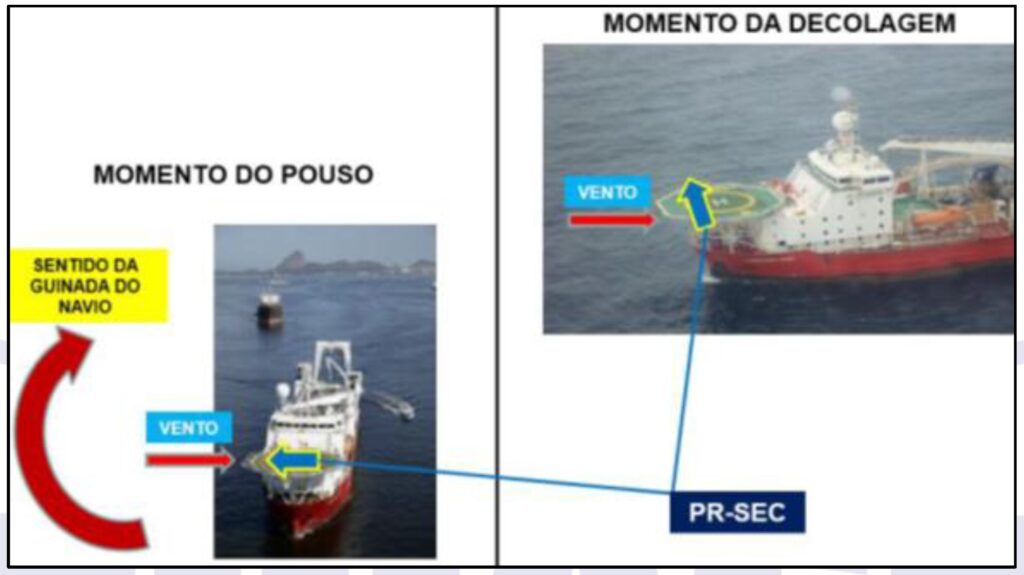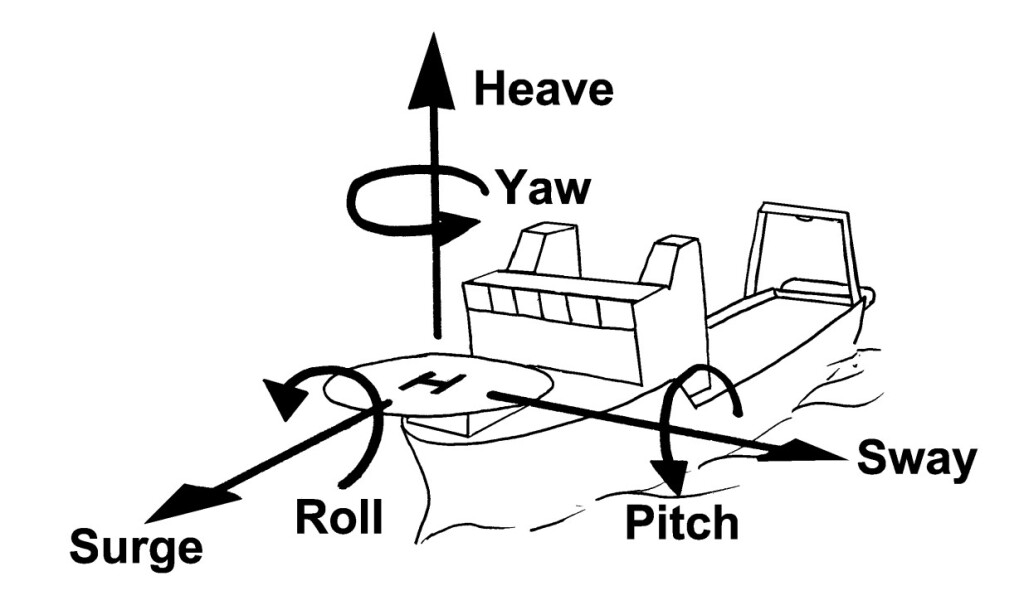Urgent Exit Required: A Helideck Incident (Omni Sikorsky S-76C+ PR-SEC)
Vessels and mobile installations in the UKCS are currently completing a long anticipated helideck upgrade to introduce the latest Rev 9b of the Helideck Certification Agency (HCA) standard of Helideck Monitoring System (HMS) with deck repeater lights. This serious incident in Brazil is a reminder of why this HMS upgrade is essential.
On 28 June 2015, Omni Taxi Aero Sikorsky S-76C+ PR-SEC, under contract to Petrobras, had to make a sudden departure from the deck of pipelaying vessel Kommandor 3000, almost colliding with the vessel’s superstructure, after the vessel had changed heading. The aircraft was undamaged and the occupants unharmed. The helicopter damaged the helideck net.

Damage to the Helideck Net of Kommandor 3000 by Omni Sikorsky S-76C+ PR-SEC (Credit: CENIPA)
The Incident
Brazilian accident investigation agency, the Centro de Investigação e Prevenção de Acidentes Aeronáuticos (CENIPA), explain in their safety investigation report (avaible in Portuguese only) that the offshore helicopter had departed from Macaé Airfield (SBME), RJ at 10:30UTC with two pilots and four passengers onboard.
Before landing, the [Kommandor 3000’s] radio operator informed [the helicopter crew of] the wind conditions (080°/17kt), the ship’s heading (351°) and the values of pitch, roll and heave.
Vessel Motion (Credit: UK CAA)
On that occasion, the first consultation was made on the possibility of changing the bow of the vessel after landing.
The aircraft landed at 11:40UTC. The Aircraft Commander was Pilot Flying (PF) and remained at the controls while rotors running on the helideck.
The four outbound passengers disembarked and four inbound passengers boarded.
During this time, the ship’s radio operator again questioned the crew about the 096° turn to heading, and the [aircraft] captain agreed with the manoeuvre. With the passengers on board, the maneuver was carried out as requested. Thus, the wind, which before landing was incident laterally on the vessel, became a bow relative to the ship, and abeam relative to the aircraft.

Change in Wind Direction as Kommandor 3000 Manoeuvred While Omni Sikorsky S-76C+ PR-SEC was on the Helideck (Credit: CENIPA)
During the vessel’s turn CENIPA say the wind was 29 knots and the vessel was “struck by a wave”, which caused an “aggressive…pitch-up, propelling the aircraft upward and to the right”. The aircraft skidded across and damaged the deck net.
The Aircraft Commander perceived the motion as the start of a dynamic rollover towards the superstructure and so wisely initiated an immediate take off.
After losing contact with the helideck surface, the aircraft banked and moved dangerously to the right, passing very close to the main structure of the ship, indicating a risk of collision.
Safety Investigation
The investigation was hampered because the Honeywell Cockpit Voice and Flight Data
Recorder (CVFDR) was not functioning during the incident flight, for reasons that were not determined.
The investigators did however discover that 10 minutes prior to the landing, the earlier generation HMS was already displaying a red warning on the vessel’s bridge that at least one motion parameter was outside of limits.
Other Occurrences
We have previously discussed an accident from February 2014 in Brazil where another Petrobras chartered S-76C+ was damaged landing on a vessel without being warned that the HMS was showing exceedance: Helideck Heave Ho! (BHS Sikorsky S-76C++ PR-CHI). That prior investigation was only released 16 November 2021 (in Portuguese only), far too late to have helped prevent the 2015 near miss.
CHC AS332L G-BKZE suffered a rollover on the helideck of drillship West Navion in the North Sea on 10 November 2001. In that case the vessel had suffered a failure of the dynamic positioning system and had started to pivot around its drill string. The co-pilot was seriously injured by flying debris. Among the UK AAIB’s recommendations in their safety investigation report (issue in May 2004) was that that UKOOA (now OEUK)…
…should include in its Guidelines for the Management of Offshore Operations a requirement that, following an accident or incident (regardless of whether or not it involved a helicopter at the time), operators of vessels, Mobile Offshore Drilling Units (MODUs) and fixed installations should consider in their subsequent installation safety investigations the potential safety implications for helicopter operations on helidecks.
While adopted at the time, that set of guidelines was subsequently withdrawn. To address that gap the Flight Safety Foundation (FSF) Basic Aviation Risk Standard for Offshore Helicopter Operations (BARSOHO) states Control 5.2:
Major occurrences on installations and vessels (e.g. loss of vessel heading control, dormant failures of helideck firefighting systems or unexpected gas venting) that did not involve aircraft should be assessed for their potential impact on aviation safety with the involvement of a Competent Aviation Specialist.
On 13 January 2005 CHC AS332L G-TIGZ made an immediate departure from the fixed Tartan Alpha installation due to a storm squall hitting the installation during the turnaround. The co-pilot was left on the deck, the baggage bay was open and one passenger was unrestrained in the cabin doorway boarding the aircraft. The helicopter did a circuit and landed with no injuries. While reported to UK CAA, it was not subject to an AAIB investigation.
HMS Improvements
The HCA Standard Measuring Equipment for Helideck Monitoring System (HMS) and Weather Data, now at Rev 9b has been adopted as a standards by Bristow, CHC, NHV and OHS (formerly Babcock Offshore) for use on moving helidecks in Europe.
Rev 9b includes a requirement for repeater lights on the helideck to directly warn flight crews of deteriorating conditions both before and after landing.
On 17 December 2020 the UK CAA issued Safety Directive SD-2020/003 Offshore Helicopter Helideck Operations (superseded by SD-2022/001 on 1 June 2022) that states:
From 1 April 2021, a specified operator must not conduct commercial air transport offshore operations to an offshore location if the helideck motion exceeds stable deck conditions unless that location has a Helideck Monitoring System (HMS) meeting Rev.9 or later version of the HMS standard published on the Helideck Certification Agency’s web site, or provisions as are approved by the CAA.
A stable deck is defined as helideck pitch or roll of 1° or less, and a heave rate of 0.4 m/s or less. In most cases this would be a highly penalising limitation for vessels needing to conduct routine offshore helicopter operations.
UK CAA Safety Directive SD-2020/003 also applied enhanced fire-fighting requirements and a need to implement the so called Circle and H lighting upgrade for night operations. The latter incorporated a lighting scheme described in the 2013 CAP1077: Specification for an Offshore Helideck Lighting System.
Our Observation
This article highlights occurrences where:
- A loss of vessel control has resulted in a roll-over
- A sudden weather event necessitated an immediate departure
- Worsening sea conditions were detached but the flight crew were not alerted resulting in a partial landing gear collapse
- A deliberate vessel movement, when unbeknownst to the flight crew, the vessel was already outside of motion limits necessitated an immediate departure
These four all justify the adoption of HMS Rev 9b and repeater lights.
Safety Resources
The European Safety Promotion Network Rotorcraft (ESPN-R) has a helicopter safety discussion group on LinkedIn. You may also find these Aerossurance articles of interest:
- Review of “The impact of human factors on pilots’ safety behavior in offshore aviation – Brazil”
- HeliOffshore 2022 Conference Review
- S-92A Offshore Landing Obstacle Strike: CENIPA Report
- Fatal GOM B407 Offshore Take Off Accident: Safety, Helideck & SAR / Emergency Response Questions
- 2009 Newfoundland S-92A C-GZCH Accident: A Failure of Design and Certification
- Fatal Mi-8 Loss of Control – Inflight and Water Impact off Svalbard
- Canadian Coast Guard Helicopter Accident: CFIT, Survivability and More
- Korean Kamov Ka-32T Fire-Fighting Water Impact and Underwater Egress Fatal Accident
- NH90 Caribbean Loss of Control – Inflight, Water Impact and Survivability Issues
- Dramatic Malaysian S-76C 2013 Ditching Video
- Ditching after Blade Strike During HESLO from a Ship
- US BSEE Helideck A-NPR / Bell 430 Tail Strike
- AS350B3 Ditching Japan
- GOM Helicopter Ops 2000-2019: Single Engine Usage Plummets But Fatal Accident Rate Resistant
- S-92A Collision with Obstacle while Taxying
- Loss of Bell 412 off Brazil Remains Unexplained
- Offshore Night Near Miss: Marine Pilot Transfer Unintended Descent
- North Sea Helicopter Struck Sea After Loss of Control on Approach During Night Shuttling (S-76A G-BHYB 1983)
- Wrong Deck Landings
- NTSB Report on Bizarre 2012 US S-76B Ditching
- FOD and an AS350B3 Accident Landing on a Yacht in Bergen
- Night Offshore Training AS365N3 Accident in India 2015
- Loss of Control, Twice, by Offshore Helicopter off Nova Scotia
- Night Offshore Windfarm HEMS Winch Training CFIT (BK117C1 D-HDRJ)
- Blinded by Light, Spanish Customs AS365 Crashed During Night-time Hot Pursuit
These free case studies are published to help advance aviation safety.
The UK CAA publish the widely adopted CAP 437: Standards for offshore helicopter landing areas (now at Edition 9).


Recent Comments